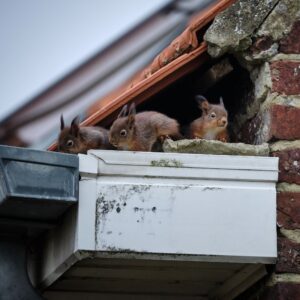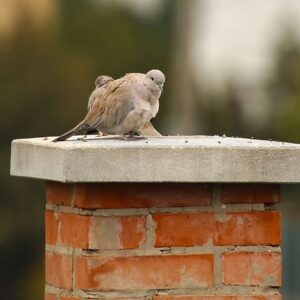Your cozy home and its inviting fireplace has the potential to attract unexpected guests – and we’re not talking about neighbors, in-laws, and your great-aunt Mildred. We’re talking about guests of the animal variety.
It’s not uncommon for animals to find their way into chimneys, seeking refuge from the elements or predators, or mistakenly stumbling upon what they perceive to be an ideal shelter. But once in your chimney, birds and mammals aren’t innocuous in their effects. How should you respond to an animal in your chimney system? And what preventative measures can you take to keep them out?
Here are some basics about what happens – and what action you should take – when animals find their way into your chimney. And if you have additional questions, be sure to reach out to see how we can help.
Why Are Animals in My Chimney?
Some common chimney intruders include:
 Birds. Chimneys often resemble natural nesting spots for birds, providing elevation and shelter for their nests.
Birds. Chimneys often resemble natural nesting spots for birds, providing elevation and shelter for their nests.- Squirrels and raccoons. These agile climbers can scale your home or use any overhanging branches as convenient pathways to your chimney. They may mistakenly venture down in search of a secure place for a den or a rest.
- Bats. Because they’re dark and secluded, chimneys can be appealing as a roosting spot for bats.
- Rodents. Mice and rats are notorious for exploring any accessible spaces in search of food or shelter.
It may seem harmless to have an animal nesting in your chimney, especially if it isn’t during the burning season, but there are a number of issues that playing host to wildlife can present.
Animals can obstruct the chimney flue, either with their bodies or with debris they create or carry in, preventing proper ventilation. These blockages can increase the risk of harmful gases like carbon monoxide entering your living space. Blockages also become fire hazards, increasing the risk of a chimney or other uncontained fire.
Animals don’t also create blockages in your flue, they can also create damage in your chimney system. Gnawing, scratching, and nesting can cause structural damage to your chimney’s interior. And there are health risks associated with animal droppings, parasites, and diseases that some animals carry, as well as the unpleasantness of noises and odors animals can generate.
How Should I Respond To an Animal in My Chimney?
If you suspect – or have confirmed – that there’s an animal in your chimney, there are two calls you may need to make. If a live animal is trapped and in distress, you can call animal control or a licensed wildlife removal service. They’ll use their training to try to execute a humane removal with attention to safety. Keep in mind that animals that are afraid can act unpredictably, so keep children and pets out of the way.
Calling your chimney technician may also contribute to animal removal, as we have tools that help us access different areas of your chimney system. In prefabricated fireplaces, animals may find their way into areas outside the flue, which will require specialized removal techniques.
Abstain from using your heating appliance if you have an animal issue. While some homeowners think smoke will drive animals out, if the animal is trapped or can’t make its way out and dies, your problem is increased rather than solved!
It’s important to know that one creature that’s particularly partial to chimneys is the aptly named chimney swift, a gray, acrobatic, migratory bird that can’t perch. Instead, chimney swifts cling to vertical surfaces, using their saliva to create nests to adhere to places like the inside of your chimney flue. These birds are protected by the Federal Migratory Bird Treaty Act, and removing an active nest is punishable by jail time and/or substantial fines. If you have a family of chimney swifts, you’ll need to wait for removal until all young have left the nest.
The Animal Is Removed – Now What?
In addition to helping remove the animal, your chimney sweep technician should be called upon to sweep and inspect a chimney that’s recently been infested. With the animal removed, sweeping the chimney will clear any leaves, twigs, droppings, feathers, or other debris from the nooks and crannies of your chimney system. This will help ensure that your system is unobstructed and ready for safe use again. If you notice odors coming from your chimney, the animal may have expired and animal removal, sweeping, and inspection is also needed.
 Another step to take once the animal is removed is asking your chimney professional about how to keep animals out in the future. This is one of those “an ounce of prevention is worth a pound of cure” cases.
Another step to take once the animal is removed is asking your chimney professional about how to keep animals out in the future. This is one of those “an ounce of prevention is worth a pound of cure” cases.
If you don’t have a chimney cap, or if it’s in disrepair, installing one will be an important first line of defense. A chimney cap sits on top of your flue, where it guards against anything entering your chimney. This won’t only help with animals, but other debris and precipitation that can be harmful for your system. The chimney cap covers the opening of your chimney exhaust while still allowing smoke and gases to vent.
Another helpful addition that may be recommended for your masonry fireplace chimney is a top-sealing damper, which helps control ventilation but would also aid in preventing animal intrusion by acting as a physical barrier. Finally, having your chimney inspected yearly will help identify and address potential entry points for wildlife and address them – as well as serving a number of other vital purposes.
Don’t Stress – We’re Here to Help
While it’s disconcerting to realize an animal has made its way into your living space, don’t panic. We’re here to help, and to offer solutions to guard against recurrence. We’re in the business of helping you keep your chimney system running safely and optimally – and that includes wildlife staying in the wild and not in your chimney!
With some action steps and a little help from your friendly neighborhood pros here at Lords Chimney, you’ll be back to enjoying your fireplace soon. Call or reach out online now.

